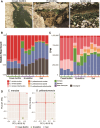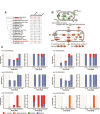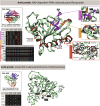Temporal dynamics in a red alga dominated geothermal feature in Yellowstone National Park
- PMID: 39711979
- PMCID: PMC11662350
- DOI: 10.1093/ismeco/ycae151
Temporal dynamics in a red alga dominated geothermal feature in Yellowstone National Park
Abstract
Alga-dominated geothermal spring communities in Yellowstone National Park (YNP), USA, have been the focus of many studies, however, relatively little is known about the composition and community interactions which underpin these ecosystems. Our goal was to determine, in three neighboring yet distinct environments in Lemonade Creek, YNP, how cells cope with abiotic stressors over the diurnal cycle. All three environments are colonized by two photosynthetic lineages, Cyanidioschyzon and Galdieria, both of which are extremophilic Cyanidiophyceae red algae. Cyanidioschyzon, a highly specialized obligate photoautotroph, dominated cell counts at all three Lemonade Creek environments. The cell cycle of Cyanidioschyzon in YNP matched that observed in synchronized cultures, suggesting that light availability plays a strong role in constraining growth of this alga in its natural habitat. Surprisingly, the mixotrophic and physiologically more flexible Galdieria, was a minor component of these algal populations. Arsenic detoxification at Lemonade Creek occurred via complementary gene expression by different eukaryotic and prokaryotic lineages, consistent with this function being shared by the microbial community, rather than individual lineages completing the entire pathway. These results demonstrate the highly structured nature of these extreme habitats, particularly regarding arsenic detoxification.
Keywords: Yellowstone National Park; community interactions; cyanidiophyceae; extremophiles; hot springs; microbiome; multi-omics.
© The Author(s) 2024. Published by Oxford University Press on behalf of the International Society for Microbial Ecology.
Conflict of interest statement
Authors declare that they have no competing interests.
Figures




Similar articles
-
Hot springs viruses at Yellowstone National Park have ancient origins and are adapted to thermophilic hosts.Commun Biol. 2024 Apr 9;7(1):312. doi: 10.1038/s42003-024-05931-1. Commun Biol. 2024. PMID: 38594478 Free PMC article.
-
Environmental constraints underpin the distribution and phylogenetic diversity of nifH in the Yellowstone geothermal complex.Microb Ecol. 2011 May;61(4):860-70. doi: 10.1007/s00248-011-9824-9. Epub 2011 Mar 2. Microb Ecol. 2011. PMID: 21365232
-
Hot springs, cool beetles: extraordinary adaptations of a predaceous insect in Yellowstone National Park.Ann Entomol Soc Am. 2025 Feb 28;118(3):237-247. doi: 10.1093/aesa/saaf011. eCollection 2025 May. Ann Entomol Soc Am. 2025. PMID: 40415970 Free PMC article.
-
Extremophilic red algae as models for understanding adaptation to hostile environments and the evolution of eukaryotic life on the early earth.Semin Cell Dev Biol. 2023 Jan 30;134:4-13. doi: 10.1016/j.semcdb.2022.03.007. Epub 2022 Mar 23. Semin Cell Dev Biol. 2023. PMID: 35339358 Review.
-
The Unicellular Red Alga Cyanidioschyzon merolae-The Simplest Model of a Photosynthetic Eukaryote.Plant Cell Physiol. 2021 Sep 30;62(6):926-941. doi: 10.1093/pcp/pcab052. Plant Cell Physiol. 2021. PMID: 33836072 Free PMC article. Review.
Cited by
-
Costs of photosynthesis and cellular remodeling in trophic transitions of the unicellular red alga Galdieria partita.Commun Biol. 2025 Jun 7;8(1):891. doi: 10.1038/s42003-025-08284-5. Commun Biol. 2025. PMID: 40483364 Free PMC article.
-
Genetic Transfer in Action: Uncovering DNA Flow in an Extremophilic Microbial Community.Environ Microbiol. 2025 Feb;27(2):e70048. doi: 10.1111/1462-2920.70048. Environ Microbiol. 2025. PMID: 39900484 Free PMC article.
-
Heterotrophic unicellular eukaryotes feeding on the unicellular red alga Cyanidiococcus sp. in moderately hot geothermal sulfuric springs.FEMS Microbiol Ecol. 2025 Apr 14;101(5):fiaf048. doi: 10.1093/femsec/fiaf048. FEMS Microbiol Ecol. 2025. PMID: 40307847 Free PMC article.
References
-
- Castenholz RW, McDermott TR. The Cyanidiales: Ecology, biodiversity, and biogeography. In: Seckbach J., Chapman D.J. (eds.), Red Algae in the Genomic Age. Netherlands, Dordrecht: Springer, 2010, 357–71. 10.1007/978-90-481-3795-4_19 - DOI
-
- Reeb V, Bhattacharya D. The Thermo-acidophilic Cyanidiophyceae (Cyanidiales). In: Seckbach J., Chapman D.J. (eds.), Red Algae in the Genomic Age. Netherlands, Dordrecht: Springer, 2010, 409–26. 10.1007/978-90-481-3795-4_22 - DOI
LinkOut - more resources
Full Text Sources

